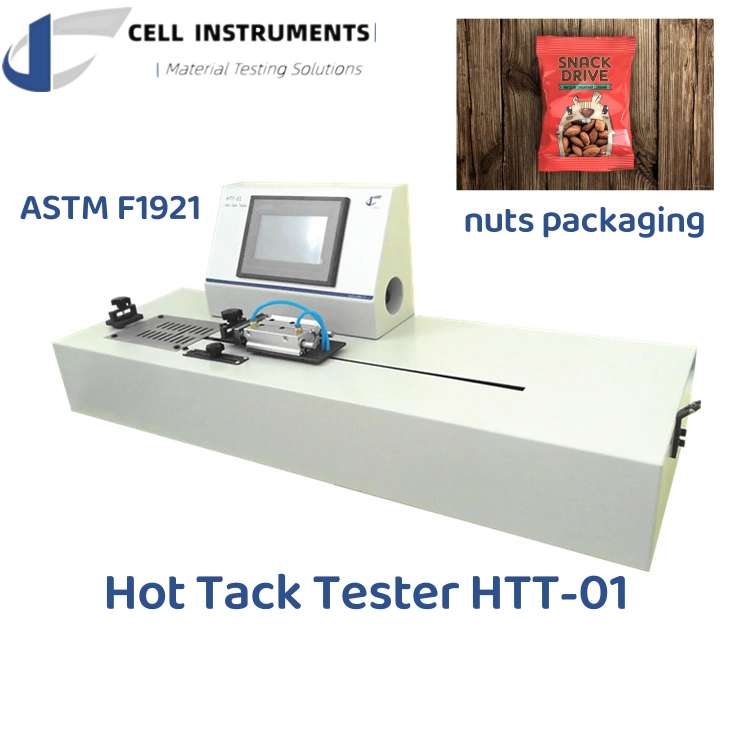Nuts Packaging and Its Critical Role
Nuts packaging plays a vital role in preserving product freshness, preventing contamination, and ensuring consumer safety. Given that nuts are often high in fat and susceptible to oxidation, packaging must offer excellent barrier properties and mechanical integrity. Among the most critical properties for packaging films used in nuts applications is the ability to seal effectively while the film is still hot—a characteristic measured by sức mạnh dính nóng.
Cell Instruments understands the nuances of packaging material performance, especially in the food sector. Through precise testing aligned with international standards like Tiêu chuẩn ASTM F1921, we help packaging professionals validate film performance and optimize sealing conditions, ultimately ensuring the reliability of nuts packaging across the supply chain.
Hot Tack Strength and Hot Tack Test Method
Hot tack strength refers to the seal strength of a packaging film immediately after heat sealing—before it has cooled. This property is essential for high-speed packaging lines, especially in vertical form-fill-seal (VFFS) applications for nuts packaging, where the seal is subjected to stress almost immediately after formation.
Why Hot Tack Matters for Nuts Packaging
TRONG nuts packaging, improper hot tack performance can result in weak seals that peel open or burst during transportation or handling. This leads to increased spoilage, product recalls, and customer dissatisfaction. Measuring hot tack strength enables packagers to:
- Optimize seal temperatures, dwell time, and pressure.
- Identify the best material combinations.
- Ensure seals resist stress before full cooling.
ASTM F1921 Test Method Overview
Các Tiêu chuẩn ASTM F1921 standard provides a structured approach to measuring sức mạnh dính nóng. Here’s a breakdown of the process:
- Seal Formation: Two strips of film are sealed under controlled temperature, pressure, and contact time using heated jaws. The film can be mono- or multilayered.
- Sample Retraction: Immediately after sealing, the test machine opens the jaws and retracts the sample, simulating real packaging line stress.
- Seal Separation: As the strips are pulled apart, the instrument measures the force required to peel open the seal.
- Measurement Modes:
- Method A (Fixed Delay): Measures hot tack strength after predefined cooling delays.
- Method B (Variable Delay): Measures the peak hot tack strength for a user-defined delay period.
The result is a force vs. time curve that helps identify optimal sealing conditions and detect weak seals under various cooling scenarios.
Recommended Testing Equipment: Cell Instruments HTT-01 Hot Tack Tester
For packaging producers and QC professionals looking to conduct precise sức mạnh dính nóng tests per ASTM F1921, the Cell Instruments Máy kiểm tra độ bám dính nóng HTT-01 is a highly recommended solution.
The HTT-01 offers:
- Compatibility with both Fixed Delay (Method A) Và Variable Delay (Method B) modes.
- Precision load cells and motorized grips for consistent test execution.
- Intuitive software for setting parameters and analyzing seal strength vs. cooling time.
- Adjustable sealing jaws with controlled heat and pressure application.
This model is ideal for evaluating film sealing performance in nuts packaging, including laminated structures, polyethylene, polypropylene, and barrier-coated films.

Practical Testing Tips for Nuts Packaging
Professionals can improve their nuts packaging testing outcomes by keeping in mind the following practices:
- Sample Preparation: Use consistent film strips with controlled dimensions. Conditioning films before testing ensures repeatability.
- Jaw Type Selection: Smooth jaws are standard, but textured jaws may better simulate industrial sealing surfaces.
- Parameter Calibration: Calibrate sealing pressure, time, and temperature based on material specs. Use ramp tests to determine failure thresholds.
- Multiple Delay Times: Test hot tack at multiple delay intervals (e.g., 0.1 s, 0.3 s, 0.5 s) to map the full cooling curve behavior.
- Record Mode of Seal Failure: Identify whether failure is adhesive, cohesive, or peel-based. This helps understand film structure interactions.
How Cell Instruments Supports Packaging Testing Professionals
At Cell Instruments, we not only offer high-precision instruments like the HTT-01 but also deliver comprehensive support for packaging material evaluation. Our testing systems are widely used in food, pharmaceutical, and consumer goods sectors to:
- Validate packaging materials.
- Benchmark film suppliers.
- Optimize process parameters.
- Ensure regulatory compliance.
We also provide customization services and automation solutions tailored to your production needs, helping you streamline QC workflows and reduce downtime.
Conclusion
In today’s competitive food market, high-performance nuts packaging is not just a value-add—it’s a necessity. By understanding and applying hot tack strength testing using standardized methods like Tiêu chuẩn ASTM F1921, packaging professionals can safeguard product integrity, improve process efficiency, and enhance consumer satisfaction.
Investing in reliable test equipment such as the Cell Instruments Máy kiểm tra độ bám dính nóng HTT-01 ensures accurate data, consistent seal performance, and long-term brand trust.
